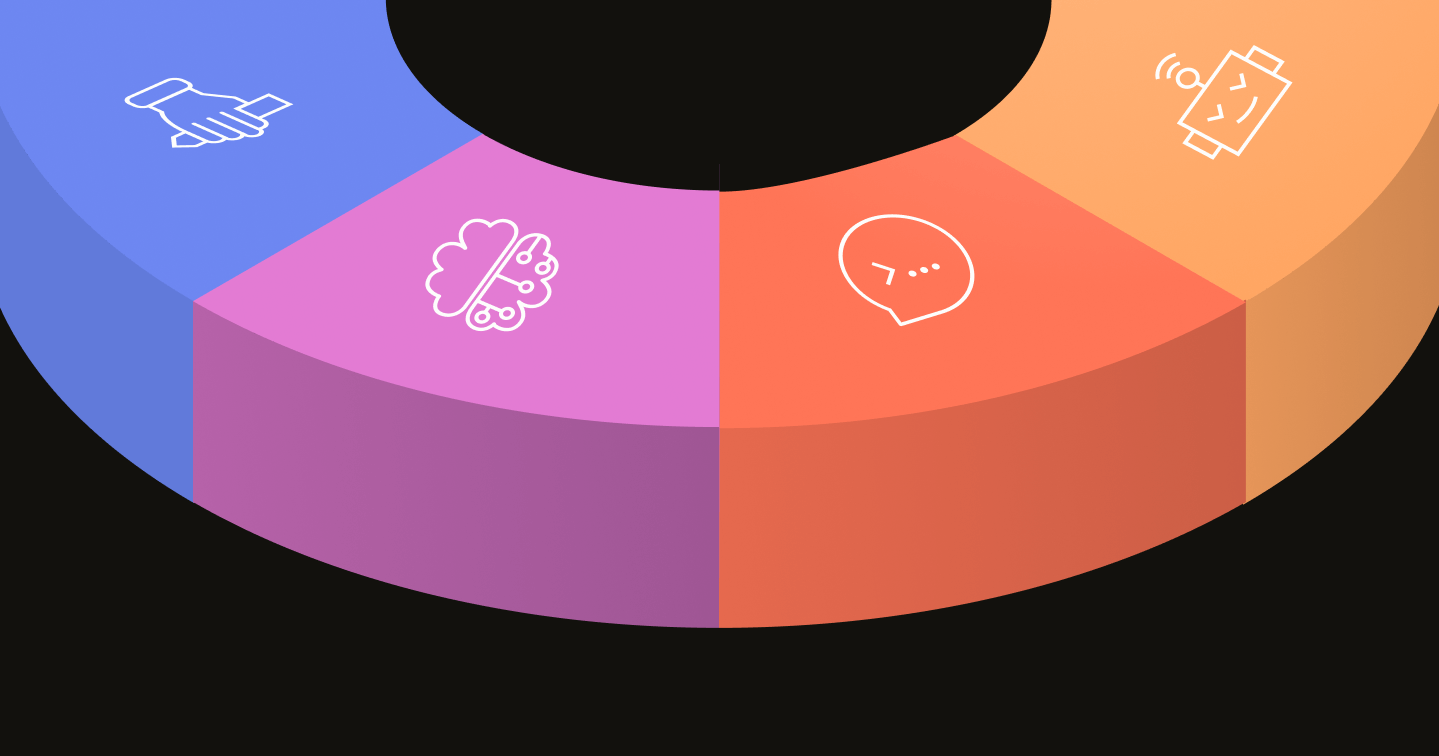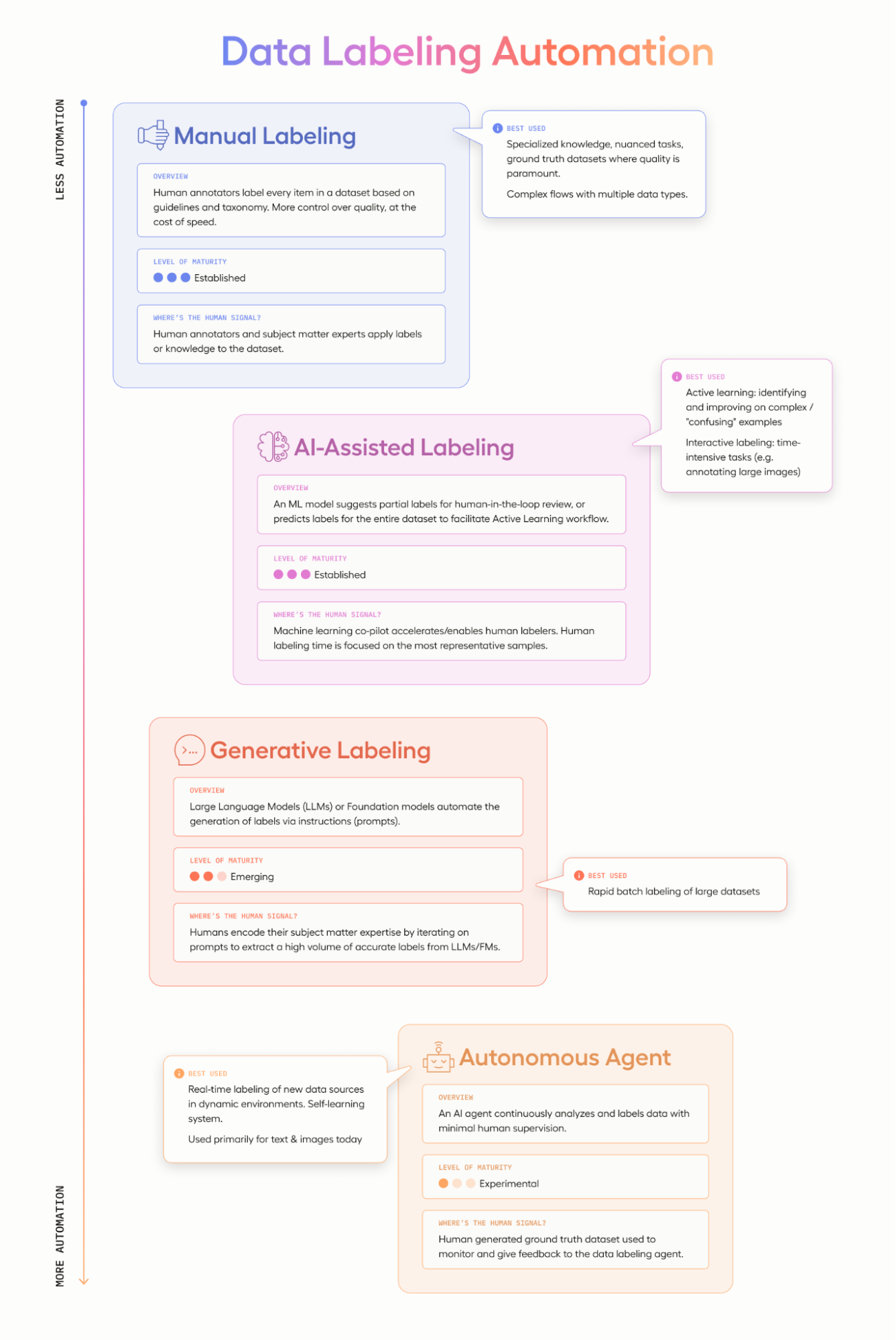Making Sense of Data Labeling Automation


Data labeling, at its core, is a bridge between raw data and meaningful insights to guide ML/AI models. While manual data labeling alone can be time consuming and expensive, by implementing automation, you can more efficiently capture and scale your organization’s proprietary knowledge to train, fine-tune and validate robust and differentiated AI models.
While you can now leverage Foundation models to bootstrap data labeling, you may sacrifice privacy and quality, especially when it comes to knowledge that’s specialized or proprietary to your business. Conversely, relying solely on manual labeling in the age of big data can increase quality, but become expensive and time consuming.
The key is finding the right balance of human expertise and AI efficiency depending on your use case and goals. We call that human signal; it’s even our name. It’s that essence of human intelligence that, when combined with automation, can unlock the true potential of AI.
What data labeling teams and data scientists face today is the Goldilocks problem. As you weigh the benefits of automation and data labeling, you may find yourself trying in the same shoes as Goldilocks did with the Three Bears, where manual labeling is too resource intensive and full automation doesn’t provide the required precision. To help guide your decision-making, we’ve summarized the different approaches to data labeling automation in four key buckets, some of which are well established today and some of which are pushing the edge of innovation. Let’s dive into the use cases, benefits, and limitations of each.

Level of Maturity: Established
At the most basic level of the spectrum lies manual labeling. Human annotators meticulously label every item in a dataset based on specific guidelines and taxonomy. This method offers unparalleled accuracy and control, ensuring each label is as precise as possible. Historically, manual labeling is how most labeling has been accomplished.
Manual labeling shines in scenarios that demand specialized knowledge or nuanced understanding. It's the go-to choice when creating ground truth datasets where quality is paramount.
The essence of manual labeling lies in the expertise of human annotators. These individuals, often subject matter experts, apply their knowledge and insights to the dataset, ensuring high-quality labels.
Level of Maturity: Established
Just because you are using human annotators, there’s no reason you can’t help them automate their workflows. As we move along the spectrum, AI-assisted labeling is a common approach used today to greatly increase the efficiency of human annotators. In this approach, Machine learning models make predictions or suggest partial labels, facilitating a human-in-the-loop review. The synergy between human expertise and machine efficiency makes this method accurate and scalable.
A great example is Meta’s Segment Anything Model (SAM) that automatically creates image label masks that humans can approve and review, saving labelers tedious work.
AI-assisted labeling is ideal for complex workflows involving multiple data types. It leverages active learning to identify and refine complex or ambiguous examples, making it perfect for intricate tasks.
In AI-assisted labeling, humans are pivotal in refining and verifying machine-generated labels. Their expertise ensures that the final labels are both accurate and meaningful. One of the ways that this AI assistance takes shape is through pre-annotation. With pre-annotation, an ML model will label the items in the dataset, which is often less accurate but much faster than human annotators. Pre-annotation allows annotators to focus on verifying and refining the automatically generated labels rather than starting from scratch, which is also much faster than pure manual labeling.
Another way that AI-assisted labeling can be used is with active learning. With active learning, an ML model labels a dataset. Ideally, using software to help, you can then prioritize the most uncertain samples for human review, ensuring that human annotators spend their time on the most impactful data points. This combination of ML integration and active learning accelerates the data labeling process and enhances the overall quality and consistency of the annotations.
Level of Maturity: Emerging
Venturing further along the automation spectrum, we encounter labeling powered by Large Language Models (LLMs) or Foundation models. These advanced models generate labels based on specific instructions or prompts, offering a high degree of automation. LLM-based labeling is ideal for real-time labeling in dynamic environments. It's primarily used for text and images, offering rapid labeling capabilities.
Even in this advanced stage, humans play a crucial role. They iterate on prompts to refine the accuracy of the labeled dataset, ensuring that the machine-generated labels align with human understanding.
Level of Maturity: Experimental
At the cutting edge of the spectrum lie autonomous agents. These AI-driven agents continuously analyze and label data continuously, representing the zenith of automated data labeling.
With their dynamic problem-solving capabilities, agents can revolutionize the data labeling workflow. Instead of relying solely on human annotators to manually label each data point, agents can assist in pre-processing the data, identifying patterns, and suggesting potential labels. For instance, in a dataset containing images of various animals, an agent could quickly recognize and label common animals like cats or dogs, allowing human annotators to focus on more ambiguous or rare species.
Furthermore, agents can adapt in real time. If a particular labeling strategy isn't yielding accurate results, the agent can adjust its approach, learn from the feedback, and refine its labeling process. This iterative feedback loop ensures that the labeling process is continuously optimized.
Another significant advantage is the agent's ability to integrate with various tools and APIs. For example, suppose a dataset requires real-time information, like current weather conditions, for a set of images. In that case, the agent can fetch this data from relevant APIs and incorporate it into the labeling process. Autonomous agents are still experimental but show promise in real-time labeling of diverse data sources.
While autonomous agents operate with a high degree of independence, they still rely on human-generated ground truth data for feedback and refinement. They also require very light human oversight to maximize accuracy.
The fusion of human signal and automation promises a future where data annotation is both scalable and deeply insightful, and we expect this space will advance rapidly. Ultimately we want to continuously train and fine-tune the most powerful models based on accurate and differentiated data. Taking into account your use case and data type, costs, time to market, data privacy and security, you can find the best path to add automation to your data labeling pipeline.